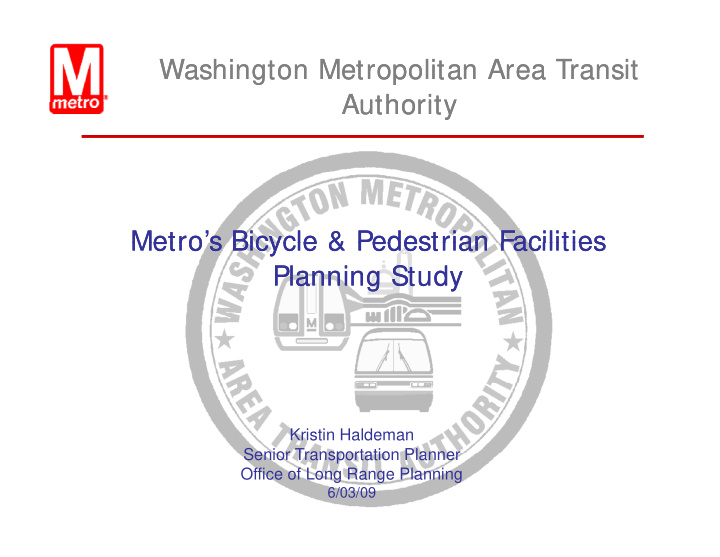



Washington Metropolitan Area Transit Washington Metropolitan Area Transit Authority Authority Authority Authority Metro s Bicycle & Pedestrian Facilities Metro s Bicycle & Pedestrian Facilities Metro’s Bicycle & Pedestrian Facilities Metro’s Bicycle & Pedestrian Facilities Planning Study Planning Study Kristin Haldeman Senior Transportation Planner Senior Transportation Planner Office of Long Range Planning 6/03/09
Purpose Purpose Purpose Purpose • Address growing bike access to stations and identify g g y future needs for bike facilities • Identify missing bike/pedestrian links within ½ mile of station areas t ti • Provide recommendations to inform Bike/Pedestrian Facilities section of Metro10 year Capital Improvement Facilities section of Metro10 year Capital Improvement Plan (CIP) 2
Metro Ridership Projections Metro Ridership Projections Metro Ridership Projections Metro Ridership Projections Projected Daily Ridership • • Between 2005 and Between 2005 and 2030, average daily rail 1,200 Rail ridership is expected to Bus 1,000 grow by over 40%, or 1.5% annually. 800 Thousands) • Over the same period, 600 average daily bus (T ridership is expected to 400 grow by 26%, or 1% annually. 200 0 2005 2010 2015 2020 2025 2030
Mode of Access to Metrorail Mode of Access to Metrorail Mode of Access to Metrorail Mode of Access to Metrorail Mode 2002 2007 AM Peak Period Walk 66,432 78,460 18% 1% Park&Ride 69,995 68,969 -1% 1% 4% Walk 9% Metrobus Metrobus 28 543 28,543 34 952 34,952 22% 22% Park&Ride Park&Ride 7% 33% Metrobus Other bus 13,033 17,620 35% Other bus 15% Dropped Off 29% Dropped Off 21,000 21,911 4% Commuter Train Ride sharing Commuter Bicycle Train 8,675 9,002 4% Ride sharing 2,606 2,463 -5% Bicycle 969 1,550 60% P&R = 29% Total AM Peak Trips Reported 216,854 240,512 11% 4
Study Overview Study Overview Study Overview Study Overview • Needs Assessment – evaluating current and potential g p demand • Best Practices Review – innovative solutions for meeting expected demand t d d d • Recommendations – putting solutions to work in the context of our system context of our system • Implementation Plan – next 10 years Timeframe – 6-9 months Public Input – Workshop; on-going web; TPB Bike/Pedestrian Subcommittee coordination 5
Bike Access Bike Access Stations w/ Most Bikes Cyclists Station Name 150.70 UNION STATION STATION 147.84 WEST HYATTSVILLE 139.88 FOGGY BOTTOM 130 15 130.15 WOODLEY WOODLEY PARK ZOO 121.77 EAST FALLS CHURCH 119.97 TWINBROOK 107 98 107.98 PENTAGON PENTAGON CITY 104.04 MEDICAL CENTER 102.30 MCPHERSON SQUARE 102 20 102.20 SILVER SILVER SPRING 6
Existing Metro Bike Facilities Existing Metro Bike Facilities Existing Metro Bike Facilities Existing Metro Bike Facilities Rail •1280 key operated lockers for annual rental •1660 racks – replacing old w/ new; 300 additional to be placed this year Bus Bus All buses equipped with rack to hold 2 bikes 7
Best Practices in Bike Parking Best Practices in Bike Parking Best Practices in Bike Parking Best Practices in Bike Parking 8
Pedestrian Access Pedestrian Access • Gap Analysis • Broad level recommendations for improving access p g • Feeding further study at individual locations 9
Land Use & Connectivity Factors Land Use & Connectivity Factors Land Use & Connectivity Factors Land Use & Connectivity Factors Suitland Station, Prince George’s Legend metrorail Metro Parking Property buildings RoadROW Suitland Suitland Braddock Road Station, Alexandria 10
Next Steps Next Steps Next Steps Next Steps • Begin project g p j • Schedule Public Workshop & Begin Outreach • Develop Website • Identify station typologies 11
Recommend
More recommend